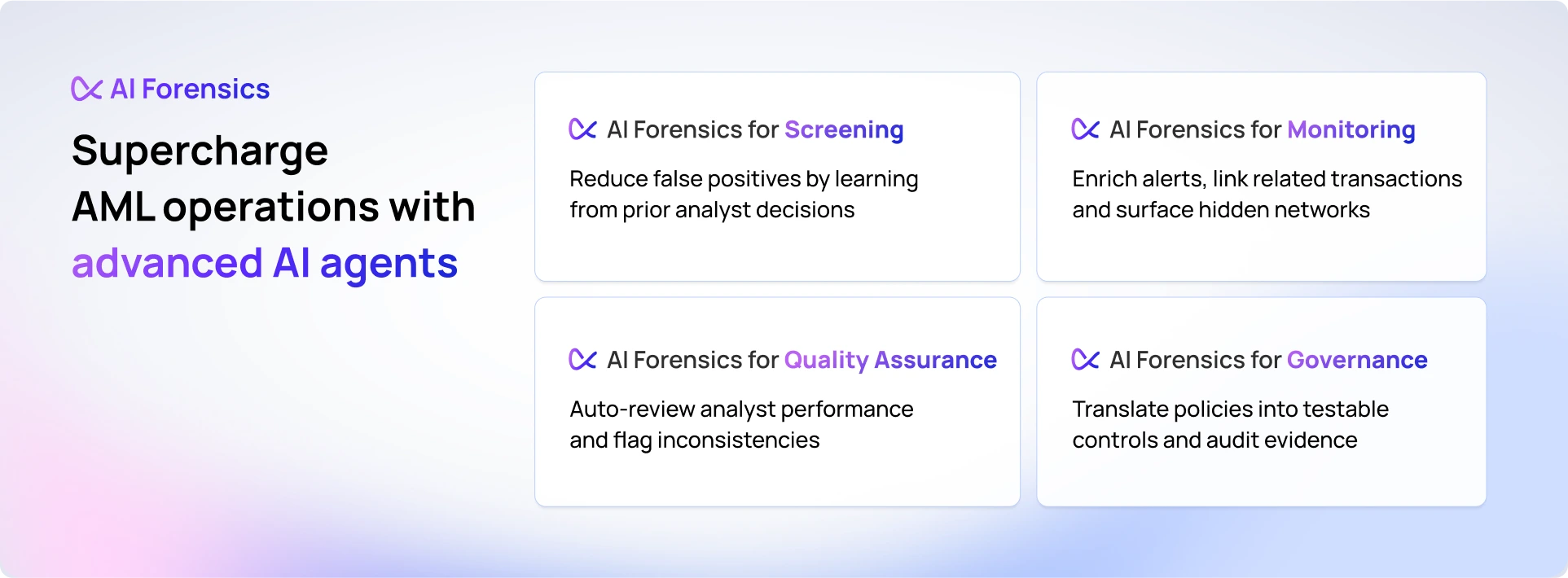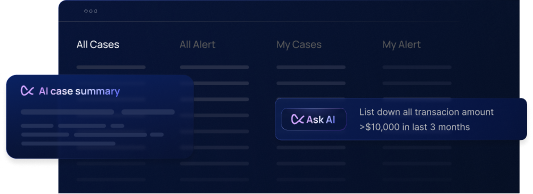The term “AI-native” is often tossed around with little clarity. But beneath the buzzword lies a meaningful and material distinction that separates the next generation of AML solutions from legacy systems still patching AI onto outdated frameworks.
So, what does it really mean to be AI-native in AML? And why does it matter for financial institutions navigating regulatory scrutiny, evolving risk vectors, and mounting operational costs?
AI-Native vs. AI-Augmented vs. Rule-Based: Understanding the Difference
There are three main categories of compliance technology today:
Rule-Based Systems
These are traditional systems relying solely on predefined rules and thresholds. While they’ve been the industry standard for years, they generate high false positives and require constant manual rule tuning. Studies reveal that 95% of alerts generated by such system are false positives costing the financial industry billions of dollars each year on wasted investigation time.
AI-Augmented Systems
Most legacy AML vendors fall into this category. These systems layer AI components as a supplementary module or analytics layer on top of their rule-based engines. However, this integration can be superficial, resulting in a Frankenstein-like architecture where AI insights are often disconnected from the core decision-making logic and limited improvements in detection capabilities.
AI-Native Systems
These platforms are built from the ground up with AI at their core. Machine learning drives detection, triage, prioritization, and even investigation processes. The AI is embedded, not appended, allowing for real-time adaptability, improved accuracy, and end-to-end optimization. Notably, AI-native systems like Flagright can reduce false positives by up to 93%.
Legacy Vendors: Bolted-On AI, Opaque Logic
Many well-known compliance vendors advertise AI capabilities, but the reality is often smoke and mirrors. Their systems remain rule-bound under the hood, with AI modules layered on top as reporting or scoring tools.
This creates several issues:
Lack of Explainability
The decision-making process is hidden, making it difficult for compliance teams to explain or defend alerts during audits.
Sluggish Adaptability
The lack of seamless integration between AI components and core systems can result in slower response times and reduced effectiveness. Modifying rules or adjusting AI behavior often requires vendor support or professional services.
Disconnected Workflows
AI flags something as risky, but the underlying rule engine either ignores it or cannot act on it natively. Besides, multiple, disconnected systems mean more manual work and higher risk of errors.
Flagright: Built AI-Native from Day One
Flagright was designed from the ground up as an AI-native AML compliance platform. Unlike legacy systems retrofitting AI, Flagright’s architecture embeds machine learning into every part of the compliance workflow:
Enhanced Detection
ML-driven behavior profiling identifies unusual activity in real time, improving detection rates from 30% to over 50% compared to rule-based systems.
Streamlined Investigation
AI triages alerts, prioritizes based on risk, and learns from feedback.
Reduced False Positives
By understanding context and behavior, Flagright's AI reduces false positives by 93%, streamlining the investigation process.
And because it’s a no-code platform, institutions can deploy quickly, customize easily, and evolve rapidly without dependency on engineering support.

The Compliance Black Box Problem
One of the primary concerns with AI in compliance is the "black box" nature of decision-making. This is unacceptable in a regulatory environment that demands clarity, traceability, and justifiability.
Flagright addresses this head-on:
Unified AI Engine
All detection, monitoring, and reporting is handled by a single, integrated AI system.
Explainable AI
Every decision made by Flagright’s models includes a natural-language explanation and a visual audit trail, supporting both internal reviews and regulatory audits.
Transparent Rule & AI Logic
Institutions have full visibility into the detection logic; no hidden rules, or vendor lock-in.
Audit-Ready Reports
Providing clear audit trails and justifications for decisions meets the expectations of regulatory bodies.
Customization
Flagright’s AI models can be tailored to the unique risk profiles of enterprises, mid-market institutions, and startups across diverse industries.
Why This Matters for Regulators and Internal Audit
Regulatory bodies around the world, including FATF, FinCEN, and the EU’s AMLA, are increasingly focused on AI governance, emphasizing the need for explainable, auditable AI in AML. Financial institutions need to ensure that AI tools can:
- Explain decisions with clear logic and supporting data.
- Demonstrate how risk scores are calculated.
- Provide consistent outputs over time.
- Be tested and validated independently.
- Provide audit trail and report for regulators and internal auditors.
Flagright’s AI-native AML compliance solution features a transparent architecture that empowers compliance teams to meet regulatory standards efficiently while building lasting trust with regulators through accuracy, accountability, and visibility.
As financial crime evolves, so must the tools we use to fight it. AI-native AML platforms like Flagright offer a clear path forward with more accurate detection, lower operational costs, and most importantly, full transparency for regulators and auditors.
Don’t settle for buzzwords. Choose an AML solution that’s truly AI-native, and future-proof your compliance program. Flagright is the partner to get you there. Don’t just take up the words; schedule a demo to see for yourself!
About the Author
Joseph Ibitola leads global demand generation at Flagright, an AI-native transaction monitoring and AML compliance platform. He drives marketing strategy, campaigns, and growth initiatives that help financial institutions adopt stronger compliance frameworks and reduce fraud risk. With expertise spanning fraud prevention, AML compliance, and financial risk management, Joseph also develops thought leadership and educational resources that position Flagright as a trusted partner to the finance industry.




.svg)





















